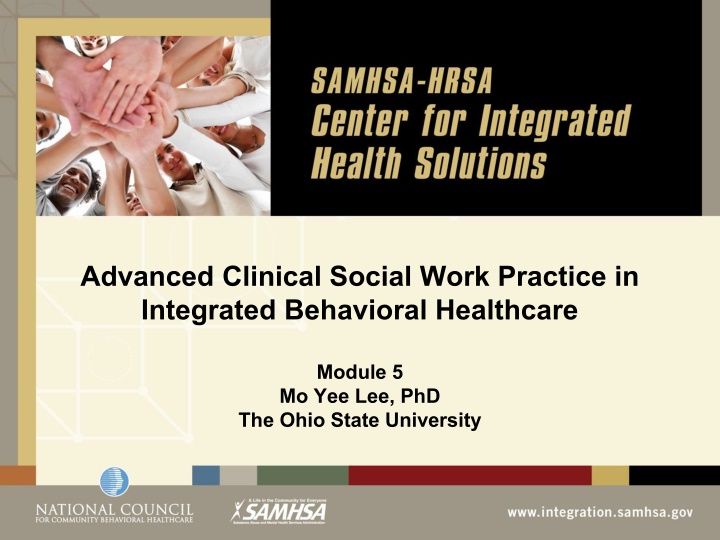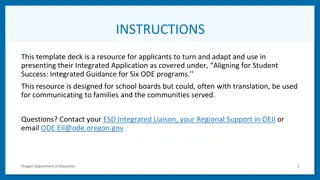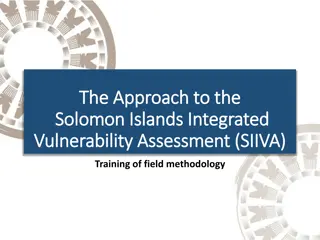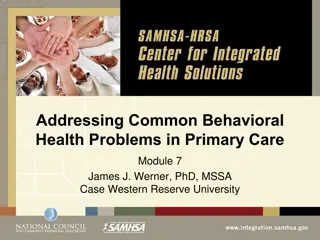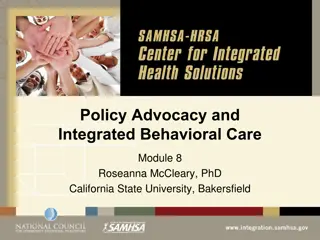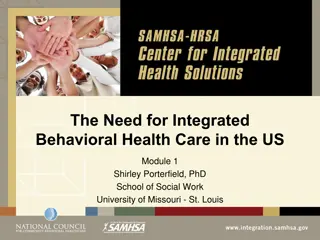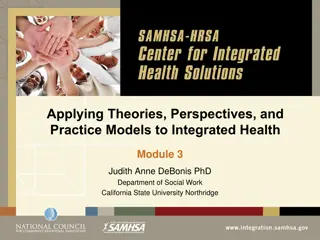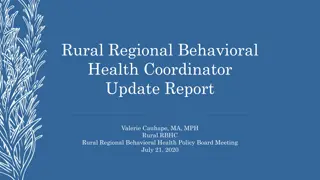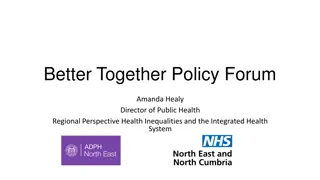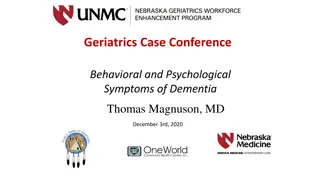Integrated Behavioral Healthcare: Assessment and Skills Development
In this module, explore comprehensive assessment skills from a holistic perspective, focusing on strengths-based and client-centered approaches. Understand the context of integrated healthcare systems and develop perceptual and conceptual skills for effective assessment. Learn tasks and processes involved in building therapeutic relationships and conducting bio-psycho-social-spiritual assessments. Dive into guiding principles emphasizing systemic interconnectedness and ongoing assessment processes.
Uploaded on Apr 04, 2025 | 1 Views
Download Presentation

Please find below an Image/Link to download the presentation.
The content on the website is provided AS IS for your information and personal use only. It may not be sold, licensed, or shared on other websites without obtaining consent from the author.If you encounter any issues during the download, it is possible that the publisher has removed the file from their server.
You are allowed to download the files provided on this website for personal or commercial use, subject to the condition that they are used lawfully. All files are the property of their respective owners.
The content on the website is provided AS IS for your information and personal use only. It may not be sold, licensed, or shared on other websites without obtaining consent from the author.
E N D
Presentation Transcript
Advanced Clinical Social Work Practice in Integrated Behavioral Healthcare Module 5 Mo Yee Lee, PhD The Ohio State University
Module 5 Comprehensive Assessment: Outline Develop assessment skills building on a Bio-Psycho- Social-Spiritual perspective Develop skills in a strengths-based assessment Develop skills in assessing client s self management skills Using assessment to build therapeutic relationship
The context Traditional separation of healthcare, mental health, and addiction systems Trend of merging mental health and addiction systems at both the state and federal level Integrated health as a movement toward integration of healthcare, mental health, and addiction systems Co-morbidity of health and mental health problems Co-morbidity of DSM:IV diagnoses Empirical evidence on the impact of systems collaboration and service delivery on patients/clients outcomes
Assessment: Perceptual/conceptual skills Perceptual skills: the ability to observe Conceptual skills: the ability to interpret observations and information in three domains Apply professional knowledge, theories, etc Understand problem context and goals Identify subjective experiences of both patients/clients and professionals
Tasks and Process of Assessment Make initial contact Develop a collaborative therapeutic relationship Use a bio-psycho-sociocultural-spiritual assessment: Person-in- environment Defining problems Assessing safety Accessing and appreciating patient/clients strengths Assess systems collaboration issues and strengths Expand awareness and perspectives Assess goals
Bio-psycho-social-spiritual assessment: A Systemic Perspective
Guiding Principles A systemic view: Everything is connected Foundational importance of bio-physiological, psychological, sociocultural, and spiritual domains in relation to multiple service systems A strengths-based perspective Assessment as an ongoing process
Bio-physiological Assessment Regular screening and tracking during psychiatric visits of the following: Health status Glucose level: high fasting blood sugar (126 mg/dL or higher), HA1c tests Lipid levels: High LDL cholesterol (160 mg/dL or higher) or low HDL cholesterol (40 mg/dL or less) Blood pressure: 140/90 or higher Weight: Body Mass Index Risk factors for heart attack and stroke Allergies: Food allergies, seasonal allergies Mobility Wellness Exercise: Exercising less than 3 days per week for at least 30 minutes? Nutrition Sleep Ensure client has primary care physician Communicate with primary care physician
Psychological Assessment Brief screening during medical visits: General psychological issues Cognitive skills and ability e.g., thought process, problem-solving/decision making skills Behavioral skills Emotional competencies: affect regulation, capacity for relating Motivational factors Overall mental status, e.g., MSE, SCL-10R Depression: PHQ9 http://www.integration.samhsa.gov/images/res/PHQ%20-%20Questions.pdf Substance and tobacco use: e.g., NIDA Quick Screen Stepped care Appropriate referral if needed Ongoing communication between PCP and BHP
Mental Status Examination (MSE) Appearance: casual dress, normal grooming & hygiene Attitude: calm and cooperative Behavior: unusual movements or psychomotor changes Speech: normal rate/tone/volume and without pressure Affect: reactive and mood congruent, labile, tearful, blunted, normal range, depressed, constricted, flat Mood: euthymic, irritable, elevated, anxious, depressed Thought Processes: goal-directed and logical or disorganized
Mental Status Examination (contd) Thought Content: Suicidal ideation: passive, active, plan? Homicidal ideation: passive, active, plan? Perception: hallucinations or delusions during interview Orientation Oriented: time, place, person, self Memory/ Concentration: short term intact, long term intact, distractable/inattentive Insight/Judgment: good, fair, poor
Sample Checklist During the past 30 days, how much have you been distressed by: NOT at all 0 A LITTLE MODER- QUITE bit ately 1 2 Extremely a bit 3 4 1. Feeling blue. 2. 3. Feeling afraid in open spaces or on the streets. Temper outbursts that you could not control. 4. 5. 6. 7. 8. 9. 10. This checklist based on items from the SCL-90, was developed by C. Rosen, K. Drescher, R. Moos, J. Finney, R. Murphy, and F. Gusman at the Center for Health Care Evaluation and the National Center for PTSD, VA Palo Alto Health Care System (152-MPD), 795 Willow Road, Menlo Park, CA 94025. See Rosen, Drescher et al. (2000: Assessment, 7, 103-111) for information on this checklist and Derogatis, Lipman, & Covi (1973: Psychopharmacology Bulletin, 9, 13-28) for information on the SCL-90. This checklist (SCL-10R) is in the public domain and permission of use was granted by Dr. C. Rosen. Your feelings being easily hurt. Feeling that you are watched or talked about by others. Difficulty making decisions. Trouble getting your breath. Feeling hopeless about the future. Feeling tense or keyed up. The idea that something is wrong with your mind.
NIDA Quick Screen NIDA Drug Screening Tool A brief survey on alcohol, tobacco, and other substance use On-line screening tool will: Tally responses Generate a substance involvement score Determine risk level Recommended level of intervention Provide additional resources for treatment.
NIDA Quick Screen question In the past year, how many times have you used the following? Drug Type Never Once or twice Monthly Weekly Daily or Almost Daily Alcohol Tobacco Prescription Drugs for Nonmedical Reasons Illegal drugs
Sociocultural Assessment Cultural values and practices Family relationship Marital status (if appropriate) Living arrangement Communication pattern Conflict resolution Satisfaction
Sociocultural Assessment Social support systems What are the social support systems Frequency Quality Housing situation/living arrangement Education Employment Financial situation
Spiritual Assessment Religious/spiritual beliefs and practices: Formal or informal Helpful assessment tools: Taking spiritual history1 Spiritual genograms2 Spiritual lifemap3 Autobiographical timeline interview4
Assessing Systems Collaboration: The Big Picture Identify all collaborating systems including formal and informal systems Assess beneficial collaborating patterns at the inter- systems level Assess barriers or problem patterns at the inter-systems level
Assessing Systems Collaboration: Relational elements5 Understand and respect each other s professional mandates, roles, and limitations Trust Ongoing contacts Availability and accessibility Validate mutual professional concerns Keeping each other informed without violating patient/client trust
Outcomes of Assessment Problems Bio-psycho-sociocultural-spiritual perspective Problem and attempted solutions specifically and behaviorally described (SOLVABLE) Exceptions to the problem pattern and strengths are identified Goals Desired future outcomes Specifically and behaviorally described (ATTAINABLE) Professional and the patient/client mutually agree to the described problems and goals Treatment plan and interventions based on mutual consensus of problem and goal
Defining SOLVABLE problems Patient/Client s perspective Specific description of patient/client s concern and problem Meaning of problem, explanatory model Attempted solutions Perceived influence/power of problems on clients Perceived influence/power of clients on problems Professional Understanding patient/client s understanding of problem Expanding patient/client s understanding of problem Offering additional helpful information or new perspective
Useful questions for understanding patient/client s concerns and problems Problem clarification What do you (or another) think is the problem? How is the problem for you? What brings you in today? In what ways can I be most helpful? Why do you think the problem exists? (explanatory model) Referral Source Who was the person who got the idea that you need to talk to me? What made him or her decide that you need some help? Previous help-seeking efforts/Attempted solutions What have you tried in the past that was helpful/unhelpful? If you ve seen some therapists before me; what did they miss with your situation?
Proper Attitude For A Strengths-base Assessment The patient/client is the Assessor, not the Professional Professionals provide a context for and facilitate a person to self-assess what is helpful for him or her in the recovery process
Strengths-based philosophy Patients/clients possess resources to solve their problems A systems perspective: Because change is constant, there must be exceptions to any problem patterns Habitual or Interactional patterns interfere with attempts to solve problems When liberated from these patterns, patients/clients can access dormant potentials or reconnect with strengths Specific problems can be brought under voluntary control Genetic predispositions, problem brain chemistry, and negative life experience do not make problems unsolvable
Assessing strengths Personal Strengths Bio-physiological Psychological Sociocultural Spiritual Strengths of the problem/symptoms Strengths in systems collaboration
Exploring the Strengths and Potential Contributions of the Problem When was the last time that you realized that the problem was helpful to you? If your problem has a voice, what do you think it is trying to share or communicate with you? How might the problem be helpful to you? If we could get rid of the problem, what might be some aspect of it that you might want to retain?
Tracking exceptions to identify strengths Tracking exceptions to identify strengths Patient/client is the assessor, not the professional Inquire about times when: The problem is absent The problem is less intense The problem is dealt with in a manner that is acceptable to the patient/client What is different about those times? Questions that allow the patient/client to specifically describe: Who, when, what, where, how
Useful Questions for Assessing Strengths What has been helpful so far? What are some of your recent successes? What are the achievements that you are most proud of having accomplished? What little things are you doing that make life a little better for you? What kinds of things do people compliment you on? When have you stopped doing something that was difficult for you to stop? When have you made an important change in your life that was difficult to make? When have you broken a habit that was hard to break? What kinds of things do people compliment you on?
Useful self Useful self- -evaluative questions evaluative questions Exception questions Outcome questions Resilience/Coping questions Past success Relationship questions Scaling questions
Characteristics of Attainable Goals Characteristics of Attainable Goals6,7 6,7 Useful: Goal is useful and meaningful to the patients/clients that they are motivated and committed to accomplish New: The goal needs to be something different, a behavior that the patient/client has not generally done before Regular:The goal is a behavior that the patient/client can do at least a few times a week Positively stated: What the patient/client can do versus what they can t do Specific and observable Small, feasible, attainable Self-initiated and not dependent on the initiation of someone else Interpersonal: When a person works on the goal, other people will be able to notice the changes and potentially be affected by the change Goals be prioritized Aligning patient/client, family, and larger system goals
Tips of useful goals The patient/client is put in charge of determining the desired outcomes of treatment Desired outcomes from stakeholders (e.g., psychiatrist, behavioral health consultant, children services, etc) are integrated into an overall plan of which the patient/client is in charge A system is devised for prioritizing goals ATTAINABLE goals Goals being stated in behaviorally specific language Goals are small and feasible Professional can offer his or her own goals and the goals must be acceptable to the patient/client
Assess clients status regarding seeking help Customer (clients who are interested to do something different for change) Visitor (clients who are not committed to change and are just looking around, include involuntary clients) Recognize and/or empathize with their dilemma Work with their goals Let clients take lead in establishing goals relevant to their perceived need Complainant (clients who tend to see problems in others but not self, usually perceive themselves as victims and complain about other people) Acknowledge/compliment their helpfulness Enlist their help in the change process
Self-management and Health Outcomes Literature Patients/clients have better health outcomes when they are able to: Self-manage symptoms/problems Actively engage in activities that maintain functioning and reduce health declines Involve in treatment and diagnostic choices Collaborate with providers Select providers and provider organizations based on performance and quality Successfully navigate the health care system
Assessing patient/client self-management skills8 Dimensions Self-manage Collaborate with providers Maintain function & Prevent decline Access appropriate and high-quality care Believe in the importance in: Have the knowledge to: Have the skills to: Can access emotional support to:
Considerations Over-assessing Burden patient/client with unnecessary assessment procedures, etc Focus on issues that are not a concern for the patient/client Lose alliance with patient/client Under-assessing Miss important issues that need to be addressed Partial or narrowly focused assessment misses important components for successful outcomes Disconnect systems goals and service coordination
Using assessment to build therapeutic relationship Therapeutic alliance9 Develop bond Agree on problems to be addressed Agree on goals and objectives Agree on tasks to achieve goals and objectives Assessment facilitates mutual understanding and consensus of problem, goals, and tasks between patients/clients and professionals A strengths-based assessment provides HOPE
References 1. 2. Bullis, R. K. 1996. Spirituality in social work practice. Washington, DC: Taylor & Francis. Hodge, D. R. (2001). Spiritual genograms: A generational approach to assessing spirituality. Families in Society 82 (1): 35. Hodge, D. R. (2005). Spiritual lifemaps: A client-centered pictorial instrument for spiritual assessment, planning, and intervention. Social Work 50 (1): 77 88. Leung, P. P. Y., and Chan, C. L. W. ( 2006). The combined use of narrative and experience-near techniques in an investigation of meaning in women with breast cancer. Psycho-Oncology, 15 (1): S5 Lee, M. Y., Ng, S. M., Leung, P., & Chan, C. (2009). Integrative Body-Mind-Spirit Social Work: An empirically based approach to assessment and treatment. New York: The Oxford University Press. Lee, M. Y., Sebold, J., Uken, A. (2003). Solution-focused treatment with domestic violence offenders: Accountability for change. New York: Oxford University Press. Lee. M. Y., Uken. A., Sebold, J. (2007). Role of Self-Determined Goals in Predicting Recidivism in Domestic Violence Offenders. Research on Social Work Practice, 17, 30-41. Hibbard, J. H., Stockard, J., Mahoney, E. R., & Tusler, M. (2004). Development of the Patient Activation Measure (PAM): Conceptualizing and measuring Activation in patients and consumers. Health Service Research, 39 (4), 1005-1026. Pinsof, W. M. (1994). An integrative systems perspective on the therapeutic alliance: Theoretical, clinical and research implications. In A. Horvath & L. Greenberg (Eds.), The working alliance: Theory, research and practice (pp. 173-198). New York: Wiley. 3. 4. 5. 6. 7. 8. 9.
